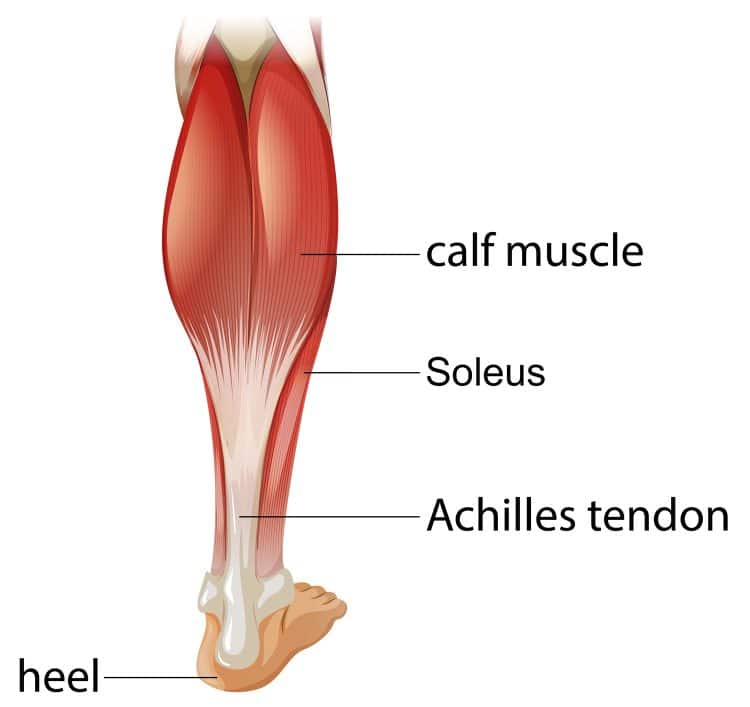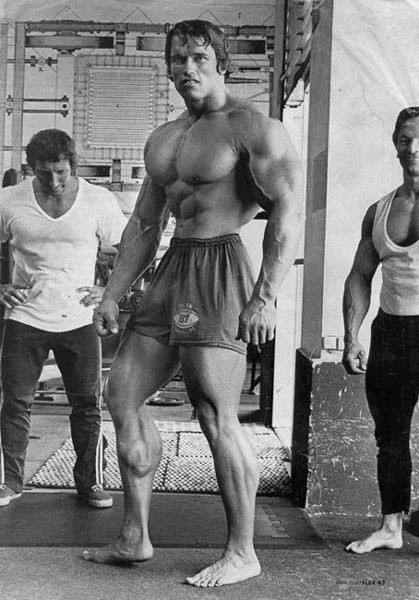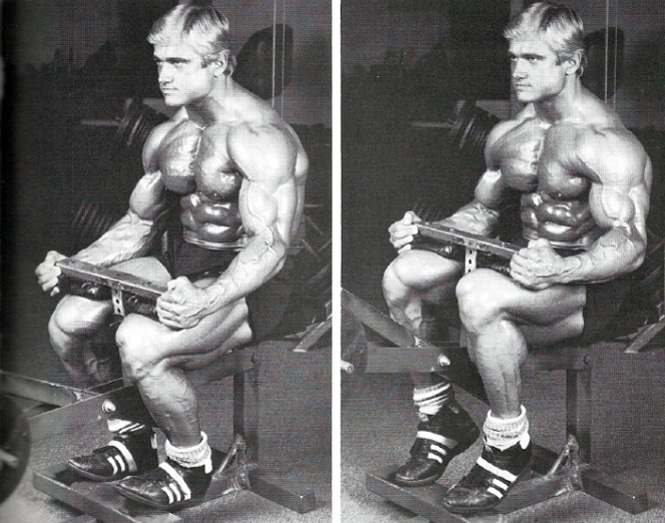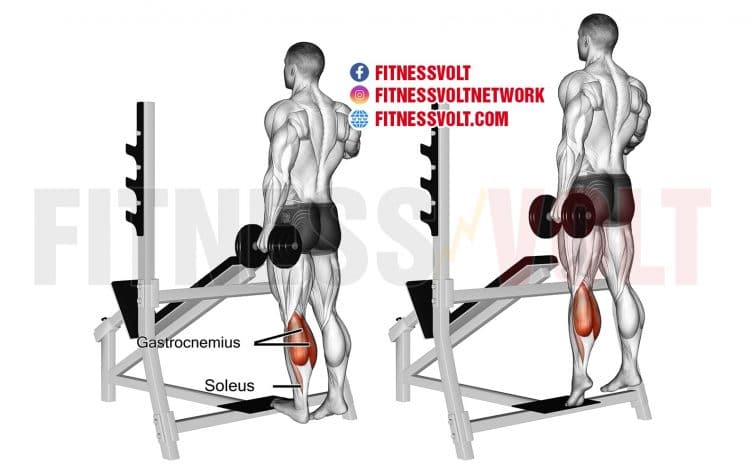Ask most bodybuilders with great calves how they train, and they’ll probably tell you that they do a mixture of seated and standing calf raises one to two times a week, doing 6-15 reps per set.
But, if you ask someone with poor calf development how THEY train lower legs, they’ll probably tell much the same story.
It seems that some people are genetically blessed with very responsive calves, but, in contrast, others are doomed to have skinny lower legs forever.
That said, if your calves don’t respond to typical training regimens, maybe it’s time to try something new. After all, if what you are doing isn’t working, you’ve got nothing to lose, right?
In this article, we reveal why your calves won’t grow and what you can do about it.
- Calf Anatomy
- Why Your Calves Are Skinny
-
How to Build Bigger Calves
- 1. Train your calves more often
- 2. Work your calves first, or even on a separate day
- 3. Vary your sets and reps
- 4. Include some explosive calf movements in your workouts
- 5. Prioritize the soleus
- 6. Vary your exercises
- 7. Use training systems to raise the intensity of your workouts
- 8. Strengthen your mind-muscle connection with isometrics
- 9. Don’t forget to stretch your calves
- Wrapping Up
Calf Anatomy
You don’t need an intimate knowledge of calf anatomy to build muscular lower legs. Still, it can be helpful when determining the best exercises for your workouts. So, let’s take a quick look at the muscles that make up your calves.

Your calves are actually two major muscles, which, collectively, physiologists call the triceps surae…
Gastrocnemius
The gastrocnemius is the dual-headed outermost calf muscle. The gastroc is a biaxial muscle, meaning it crosses two joints – the ankle and the knee. As such, it has two primary functions.
The first function of the gastrocnemius is plantar flexion of the ankle. This means pointing your toe, as happens during standing calf raises.
The second function of the gastrocnemius is knee flexion. It works with the hamstrings to help bend your knees. Watch your calves during leg curls to see them contract to aid your hamstrings. However, this is quite a weak action compared to plantar flexion.
Soleus
The second calf muscle, the soleus, lies beneath the gastrocnemius, and only the lower section is really visible. Unlike the gastroc, the soleus is a uniaxial muscle that only crosses one joint; the ankle. Surprisingly, the soleus is the biggest of the two calf muscles, and also the strongest.
The soleus only has one function – plantarflexion.
While soleus and gastrocnemius work together, it is possible to emphasize the soleus by working with bent knees. When your knees are bent, the gastrocnemius is put into a semi-relaxed position and cannot contribute as much to plantar flexion.
So, if you want to train both calf muscles, exercises like straight leg calf raises and donkey calf raises are the way to go. But, if you want to deemphasize the gastroc and hit the soleus more, bent-knee exercises such as seated calf raises are more effective. For this reason, most calf workouts include both types of calf raises.
Why Your Calves Are Skinny
Training any muscle and not getting the results you want is very frustrating. But, in the case of calf size and strength, there may be reasons that your lower legs aren’t growing.
The most common causes of poor calf development are:
1. Genetics

The most regularly cited reason for skinny calves is poor genetics, and this excuse does hold water. Some people are blessed with the right genes to build large, muscular calves. A few people have great calves, even though they don’t train them.
Muscles are made of varying amounts of different muscle fibers – type 1 slow twitch and type 2b fast twitch. Type 1 muscle fibers are made for endurance. They’re slow to fatigue but don’t have much capacity for strength or size.
In contrast, type 2b fibers are less fatigue-resistant but have a higher capacity for growth and force production.
Your ratio of slow to fast twitch muscle fibers is an inherited trait, and there is nothing you can do about it. However, while your fiber type will determine your ultimate calf development, you can overcome your genetics to a degree by working harder and smarter.
For example, if the usual approach of 3-4 sets of seated and standing calf raises for 6-15 reps isn’t working for you, more of the same won’t help. Instead, you need to do something dramatically different to shock your calves into growth.
So, while genetics will determine your calf size, most people can still build great calves if they try hard enough and are persistent. However, your results will always be less than someone blessed with superior calf-building genes.
2. Not enough training volume
Are your arms bigger than your calves? Newsflash – they should be about the same size. So, if your biceps measure 16 inches in diameter, so too should your calves. Of course, if you are reading this article, there is a good chance your calves are smaller than your arms.

One likely reason for this is that you train your biceps and triceps more than your gastrocnemius and soleus.
Think about it like this: you probably train your biceps and triceps directly 1-2 times per week, but also indirectly during every pulling and pushing exercise in your upper body workouts. Even if you train your calves twice a week, you probably do far fewer sets.
For example, if you do four sets each of bench presses, chest presses, and push-ups, your triceps get 12 sets of work, all of which will contribute to arm size.
Then, if you also train your triceps independently, you’ll probably do another 6-8 sets of direct work. And don’t forget all those shoulder-pressing exercises, too.
That adds up to at least 20 sets of triceps training volume per week, and the same is undoubtedly true for your biceps.
Yet, many lifters only do 6-8 sets of calf training per week.
With this in mind, it’s not really much of a mystery why some lifters have puny calves!
3. Not enough variation
Most experts agree that you should vary your program for optimal results. As such, most lifters change their workouts every 6-8 weeks and make small changes on a weekly basis by increasing their weights or doing more reps.
These changes are partly responsible for your ongoing progress.
However, many people fall into the trap of training their calves with the same exercises and set and rep scheme for months and even years. Repeated bouts of the same training will not maintain muscle growth.
The definition of insanity is doing the same thing over and over and expecting different results. If you want your calves to grow, you need to vary the training stimulus from time to time, as you would for any other muscle group.
4. Not treating calf training as a priority
When do you train your calves? For most people, the answer is at the end of your leg workout. While this can work for some, it’s not ideal for others. For example, after plenty of sets of squats, leg presses, hack squats, leg curls, Romanian deadlifts, etc., you are probably tired and unable to put much effort into your calf training.
You may even cut your calf workout short as you feel satisfied with how hard you’ve worked your other leg muscles. Of course, your calves won’t get the stimulation they need to grow if this is the case.
How to Build Bigger Calves
Now you know the reasons why your calves won’t grow, here is some practical programming advice for turning those baby calves into fully matured cows!
Some of this information contradicts the standard approach to calf training, but that’s okay. Remember, if what you are doing isn’t working, you need to try something different.
1. Train your calves more often
One calf workout per week isn’t enough. It’s time to pump up the frequency and hit your calves every other day, e.g., Monday, Wednesday, and Friday. Initially, this will cause some muscle soreness, but in a couple of weeks, your body will adapt, and this will no longer be a problem.
Vary your program and avoid doing the same exercises two workouts in a row. More on that later…
2. Work your calves first, or even on a separate day
If you want your calves to grow, it’s time to treat them as a priority. Work them first in your workouts or, better still, train them on their own.
But, before you say that’s not practical, remember that you can train your calves at home using nothing but a step and a dumbbell, or even just your bodyweight. Home calf workouts are an easy way to supplement your gym workouts.

3. Vary your sets and reps
Don’t just do the same old 3-4 sets of 6-15 reps for your calves. Instead, include some low weight/high rep and heavy weight/low rep training in your workouts. This will ensure that, regardless of your muscle fiber dominance, they will all receive an equal amount of stimulation.
4. Include some explosive calf movements in your workouts
Some of the most well-developed calves belong to athletes who never do any direct calf work. This strongly suggests that power exercises may be helpful for building bigger calves. Include box jumps, sprints, jump rope, and other plyometric exercises in your calf workouts.
You don’t need to do these exercises every time you train your calves, but a couple of times a week could unlock new calf growth.
Alternatively, you can do jumping calf raises in the gym:
How to do it:
- Load up the calf raise machine with a heavy load. Get into position with your shoulders under the pads and toes on the edge of the footrest.
- Lower your heels slowly down toward the floor. Get a good stretch.
- Bend your knees and then explosively jump up into your tiptoes.
- Lower slowly again and repeat.
You can also do a similar movement on a leg press machine:
5. Prioritize the soleus
Most calf workouts start with standing calf raises. This makes a certain amount of sense given that standing calf raises preferentially target the gastrocnemius, which is the most visible calf muscle.
However, it’s actually the soleus that’s bigger, and developing this muscle will build size in the entire calf complex.
So, flip your calf workout on its head and train the soleus first. That means starting your calf workout with seated calf raises. As soleus often comprises mainly slow twitch muscle fibers, do 15-20+ reps with short rests between sets.
6. Vary your exercises
Don’t just do the same calf exercises over and over again. Instead, inject your calf workouts with some variety. Yes, all calf exercises involve ankle plantarflexion, where you point your toes away from you. However, there are plenty of ways to overload your calves and keep your workouts fresh and productive.
These articles list LOADs of different calf exercises!
- Best Calves Exercises
- The 11 Most Effective Calf Raise Exercises
- 13 Best Calf Raise Machine Alternatives
- 8 Best Soleus Exercises and Stretches
- Calf Exercises You’re Probably Not Doing But Should Be
7. Use training systems to raise the intensity of your workouts
While you should always train your calves hard, training them beyond failure may trigger additional hypertrophy. This is best done using workout intensifying training systems, which are recognized methods that allow you to work much harder than usual.
Good options include:
- Drop sets
- Static holds
- Partial reps and burns
- Rest-pause
You can read more about training systems here.
However, you should use and not abuse training systems and only incorporate them into your workouts 1-2 times per week and only for one exercise. More than this could lead to overtraining.
8. Strengthen your mind-muscle connection with isometrics
You won’t be able to fully develop a muscle if you can’t control it, tense it at will, and feel it working regardless of what exercises you are performing. Reconnect your muscles with your nervous system by using isometrics.
With isometrics, you contract your muscles against an immovable object. This reinforces the mind-muscle connection.
One way to do this is to use a yoga strap or similar. You can do seated and standing isometrics to target the calves.
9. Don’t forget to stretch your calves
All this extra calf training could leave your muscles feeling short and tight. Left unchecked, this could increase your risk of injury and even Achilles tendonitis. Prevent any problems before they start by stretching your calves often.
Simply stand on the edge of a step, and let gravity pull your heels down toward the floor. Stay in this position for 60-90 seconds, descending a little further as you feel your calves relax. Do this several times a day to keep your calves flexible.
Wrapping Up
Many people are very quick to blame genetics for their lack of calf size. However, in many cases, poor programming and too little effort are actually the cause.
That’s not to say that genetics DON’T play a part, but all that usually means is that your calves respond more slowly to training.
So, stop making excuses for your skinny calves, and start putting the information in this article into action. Plenty of lifters with poor genes have built awesome calves, and, with a bit of time and effort, you can too!


